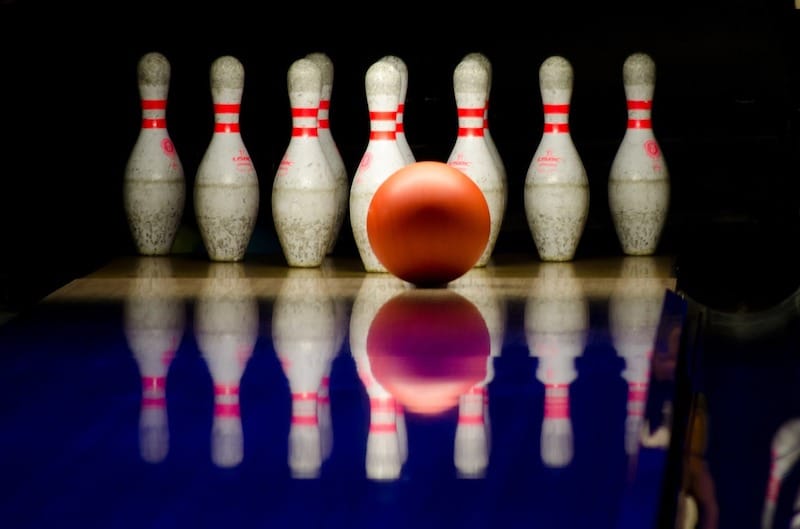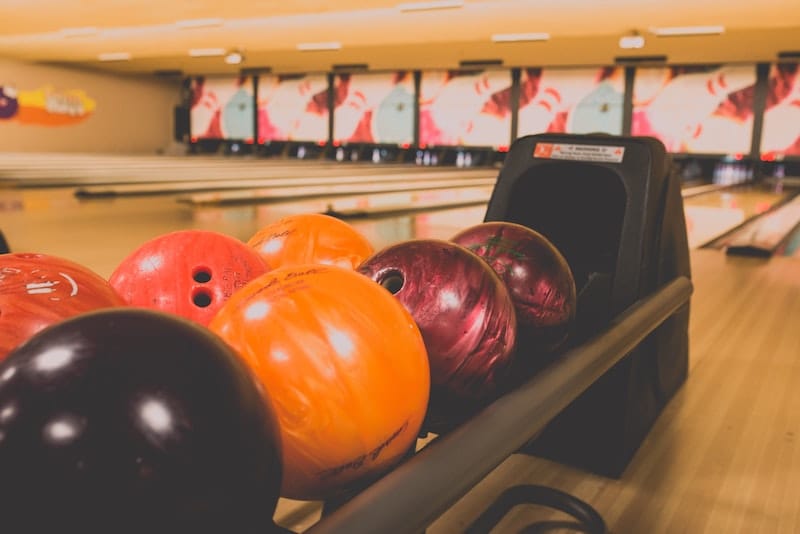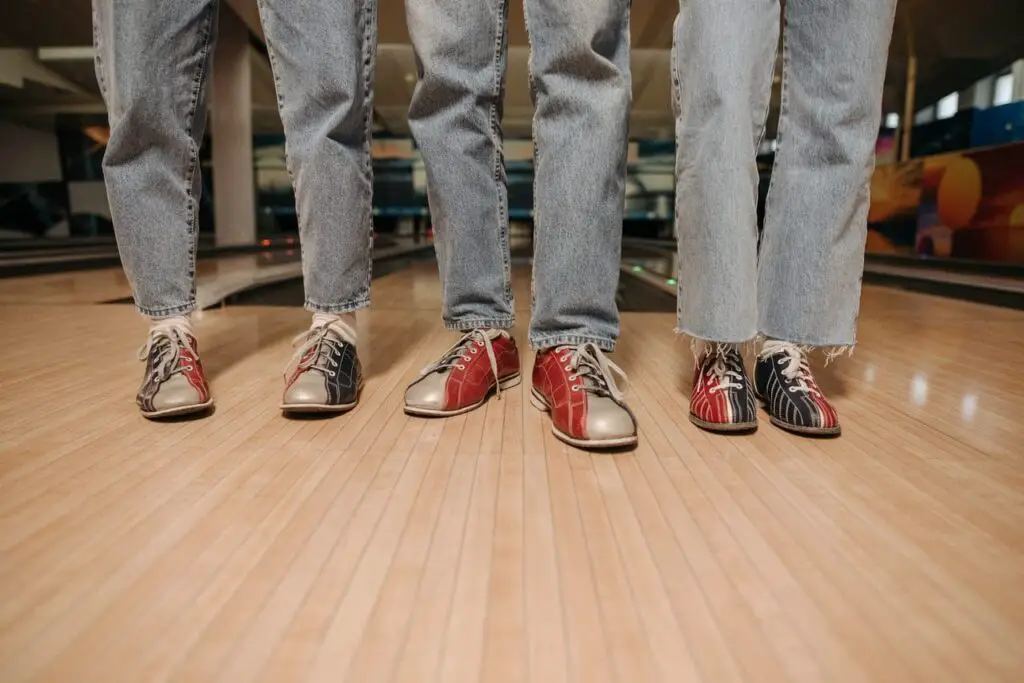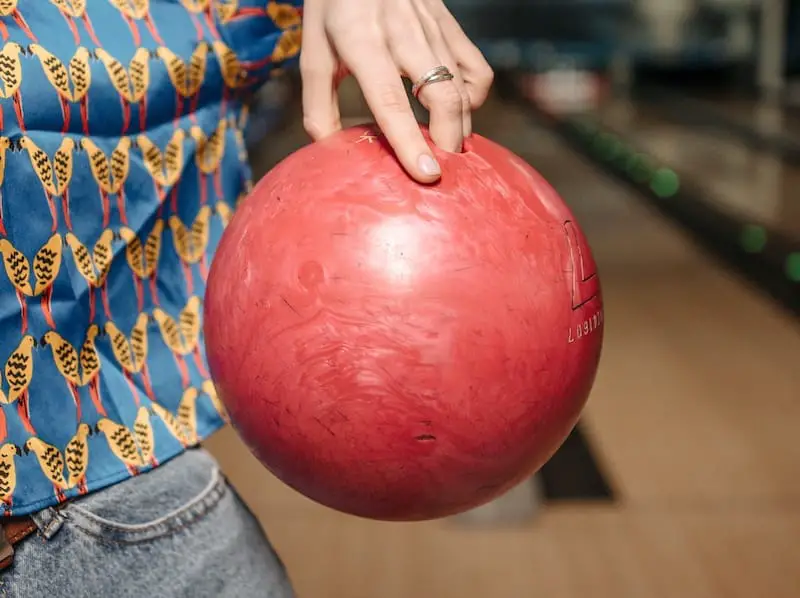If bowling ball speed is important to you, it may be hard to find a bowling alley that has a bowling ball speed gun. You can still measure bowling ball speed with just some simple math!
To measure bowling ball speed without a speed gun, count the seconds it takes the bowling ball to reach the pins. Divide 60 feet (the length of the lane) by the number of seconds. To convert to miles/hour, multiply the value by 3600 seconds/hour and divide by 5280 feet/mile.
In this post, we will cover how you can measure your bowling ball’s speed when the alley you are in does not have a speed gun. Keep reading to learn about measuring your bowling ball’s speed without a speed gun.

Measuring Bowling Ball Speed without a Speed Gun
The bowling ball speed can be measured without a speed gun by timing the bowling ball. This is quite an easy way to do things, especially if you do not have a speed gun. Just grab your calculator!
List of steps you can use to measure your bowling ball speed with some simple math:
- Ask the lane length at your local alley. Generally, this number is 60 feet
- Time to bowl. Bowl as you normally would and record your bowling
- Count the seconds. When you review the recording count the seconds from when the bowling ball leaves your hands until it reaches the pins
- Divide. Divide 60 feet by the number of seconds you counted based on your recording
- Multiply. Multiply by 3600 seconds per hour to get your numbers from feet per second to feet per hour
- Divide. Divide by 5280 feet per mile to get your final value in miles per hour
As you can see bowling ball speed is not just about bowling balls. It takes a bowling alley lane length, simple math, and the number of seconds to complete the calculation. And you can do all this without a speed gun!
Example of using the calculation method:
- The bowling alley lanes are 60 feet
- You throw a bowl and your ball reaches the pins after 3 seconds
- You divide 60 by 3 and get 20 feet per second
- You multiply 20 feet per second by 3600 seconds per hour
- You then get 72,000 feet per hour
- Divide 72,000 by 5280 feet per mile
- Your final answer is that you bowl at a speed of 13.63 miles per hour
- You can repeat these steps 3 times and then get an average
Getting an average will better help you understand how often you bowl at a certain speed. But the basic calculation you need to know is distance divided by time. This will help you determine and keep track of the speeds you calculate regularly.
How Do You Get An Average Speed?
When you do not have a speed gun it can take a little extra effort to calculate your average bowling ball speed. You can calculate your average speed by following these steps:
- Start from the first step. Repeat the steps for the calculation three times.
- Add. After you’ve calculated your speed on three different bowls, you add them together.
- Divide. Divide the total number of speeds by three to get the average.
This will give you an average over time to see how similar your bowling throws tend to be over time.
Example of how to calculate bowling ball speed average:
- Say you bowled at 13.6 miles per hour, 15 miles per hour, and 17.3 miles per hour.
- Add all three values together to get 45.9.
- Divide 45.9 by three.
- The final value you get is the average miles per hour for your bowling ball’s speed, which is 15.3 miles per hour.
Now on top of calculating your average, the original speeds you use are averages for your single bowl. This is because as the bowling ball reaches the pins, it has already lost about 2.5 miles per hour of speed.
To be able to calculate your bowling ball’s speed once it is released you would need a speed gun. And you could use that to demonstrate the idea that the bowling ball loses speed over time.
Many professional bowlers on television have their bowling ball speeds captured at release. Keep this in mind when you start comparing your numbers to their numbers.
Rarely will an alley have a release speed gun right at the foul line. Oftentimes speed guns at your average alley, if they have them, will measure the speed of your bowling ball about 50 feet down the lane.
This means the speed you calculate or see at your local bowling alley will differ significantly from the professional bowlers you see on television simply because you are taking the speed calculations or readings at different time points in the single throw.
What Speed Is Considered Fast for Bowling Ball Speed?
In competitions, you can see bowlers bowling at average speeds of 20 to 22 miles per hour at release. And because a bowling ball slows down as it travels down the lane, due to friction, a pro bowler’s balls tend to impact the pins at 17 to 18 miles per hour.
The bowling ball speed depends on your bowling style and the bowling alley you are bowling at, but it is safe to say that a bowling ball above 20 miles per hour or 22 miles per hour can be considered fast.
How to Throw Faster Shots in Bowling
There are a few different techniques people use to throw bowling balls faster. And you can see many of these techniques demonstrated with professional bowlers in competition.
Techniques to use to bowl fast shots:
- Loosen up your arm – You want to be fairly loose when bowling. If you tend to tense up at the foul line, it will be reflected in slower bowling ball speeds.
- Lower the ball – One of the easiest ways to increase speed is the lower the ball closer to the floor before release. This allows more momentum to go forward with the ball than down with gravity.
- Move back – Another thing you can do is move back on your approach. If you start farther back, you get a longer “running” start. This gives you more time to build up momentum in the throw.
- Move faster – A faster approach will also lead to a faster throw. On the approach, you can step quickly to get more speed behind the bowling ball.
- Practice your swing – The swing of the bowling ball should be a whole-body exercise. Use your larger leg muscles to stabilize and draw power from.
- Train outside of the alley – One thing you can do is strengthen your muscles in the gym. Strength training offers a great opportunity to build muscle in your legs, arms, back, and abdominals.
Trying these techniques will surely quicken your bowling ball’s speed over time. And one last thing, be consistent. Consistency is key in bowling and having your steps match and your swing go back so far each time is imperative to see your bowling ball’s speed numbers increase.
How Fast Can Your Bowling Ball Roll?
Most bowling ball manufacturers claim that their bowling balls will achieve an optimum speed of between 15 and 17 miles per hour. The average person can throw a bowling ball ten miles per hour. Only experienced bowlers will be able to throw a bowling ball at top speeds regularly or with any accuracy!
The bowling ball speed numbers above are only the bowling ball’s initial speed. If you throw your bowling ball down a bowling lane, it will slow due to friction with the wooden flooring and oil applied on the surface of each bowling lane.
Since professional bowlers need to make accurate throws at high speeds, they use special “speed guns” that measure how fast a bowling ball is moving in miles per hour just before rolling down a bowling lane. These sensors help them know if there is enough power behind their rolls so that they can get strikes or pick-up spares!
But in the case where you do not have a fancy speed gun, setting up a camera behind you while you bowl to capture timings for you is very valuable.
Things to Watch Out for as You Pick Up Bowling Ball Speed
Now that we have covered how to calculate speed and how to make your bowling ball go faster, let us discuss what you need to watch out for when you are trying to increase your bowling ball’s speed.
Things to watch out for when you want to increase your ball speed in bowling:
- Overthrowing – Be careful not to overthrow, as this is a common problem when bowlers are trying to increase speed. This occurs when you try to use your upper body more in the bowl than the lower body. It is key to remember that most of your power is in your legs. Focus on your footwork in the approach.
- Tensing up during the arm swing – One thing you need is a loose, natural arm swing when bowling. You do not need to add muscle or strength you should instead focus on creating a relaxed and repeatable swing that will result in increased speed and accuracy.
- Timing it wrong – Timing is very important to speed and accuracy. When you walk up to the foul line to bowl each step must be timed to coincide with the arm swing. If any of your movements are out of alignment, then you will have issues increasing the speed of your bowling ball throw.
- Using the wrong ball fit and weight – Another big problem bowlers can run into is using the wrong size and weight bowling ball. The wrong fit causes a strained grip and wasted energy trying to maintain the ball during the swing. The wrong weight bowling ball, say it is too heavy, will cause strain on the muscles and cause a poor swing reducing speed considerably.
Does the weight of the bowling ball matter?
And why are bowling balls so heavy?
Types Of Bowling Balls And Their Speeds
The type of bowling ball you use can also have a significant impact on the final speed of your throw. If you can maximize your chances of a consistent and fast bowl then you will see speed and accuracy fall into place, too.
Currently, there are a few different types of bowling balls common on today’s market:
- Hybrid reactive coverstock
- Particle coverstock
- Pearl reactive coverstock
- Plastic coverstock
- Reactive resin coverstock
- Solid reactive coverstock
- Urethane coverstock
Most bowling alleys provide plastic coverstock bowling balls. Also, many amateurs and professionals opt for the urethane coverstock bowling ball. Some bowlers even go as far as to have multiple balls for various throws and strategies.
Each type has a different reaction on the bowling lane. This means that each ball will react differently to oil and friction as it travels down the bowling alley towards your intended target.
For example, a plastic coverstock bowling ball will provide speed, but not as much hook as urethane coverstock bowling balls which provides more movement onto the pin deck after it hits them.
A hybrid coverstock bowling ball is somewhere in between the solid and pearl types of bowling balls providing better control than pearl bowling balls without sacrificing too much hook or power.
It is important to choose a type of bowl depending on what kind of game plan you want to have during competition with other players, so be sure everyone knows what they are using.
Final Thoughts: Calculate Bowling Ball Speed with Simple Math
Calculating your bowling ball speed is a simple equation of distance over time. All you need to do is know how long the lane is and how many seconds it takes for your bowling ball to reach the pins after it is released.
Use our six-step method to figure out your average bowling ball speed without a speed gun.












